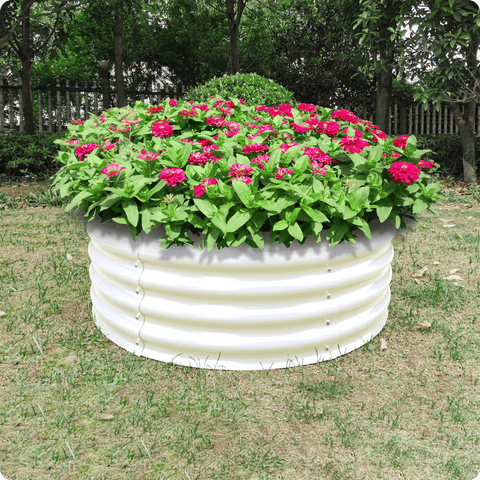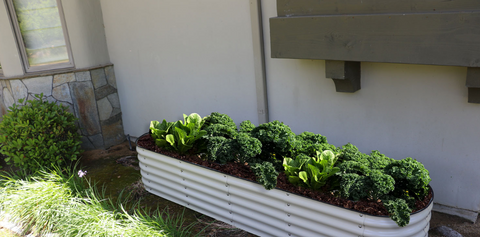Knowledge from Olle Garden Bed: Vegetable Garden vs. Flower Garden
Trying to choose between a garden or garden? Let's take a look at the differences between vegetable gardens and gardens and talk about the advantages and disadvantages of each type. Then we can talk about the third option, interspecing! Intercropping is the best way to blend the two garden types harmoniously, which is beneficial to all the plants you choose to plant. The following content also has some reference value for raised garden beds.
Growers can assemble two different types of gardens, vegetable gardens and gardens on their property. Traditionally, gardeners have placed their gardens in the front and side areas around the house. These spaces are high-profile, because anyone who visits or even passes the gardener's home can easily notice them. On the other hand, the vegetable garden area is usually degraded to the backyard, or hidden in a corner, and no one except the gardener will see it.

However, there are no rules or laws that prevent gardeners from using the garden plan to plant vegetables and flowers in the same piece at the same time. There are also good reasons to design gardens and plant vegetables and flowers together. Flowers attract pollinators that vegetable plants rely on to blossom and bear fruit.
Many flowers are also insect resistant and can help prevent pests from damaging vegetable crops and food planted before harvest. Therefore, if you still plant vegetables and flowers in areas that are completely independent of your property, you may need to rethink your strategy. Instead of dividing gardens, vegetable gardens and herb gardens into specific places, why not just make gardens? You may find that the end result is a better harvest.
It is more meaningful to plan your garden according to which plants are most beneficial to each other and become the best garden partner, rather than separating them according to plant types and isolating areas that allow certain plants to grow. Well, modern gardeners are doing this, allowing their vegetables and herbs to be mixed with ornamental plants, and planning their gardens according to function rather than traditional design.
Thankfully, we do not live in a world that does not approve and prevent change, avoiding and rejecting new ideas for the sake of tradition. However, the interplanting of vegetables and flowers is not even a new idea, because the British nobles mixed flowers into their vegetable gardens, which can be traced back to the Middle Ages.
In France, the practice of mixing different plant types dates back centuries. Planting vegetables and flowers in the same bed is a strategy that can increase vegetable production and keep all plants healthy and happy.
Advantages of vegetable garden
- Vegetable gardeners soon boast about how they grow their own fresh agricultural products and save money in the grocery store by harvesting their own agricultural products.
- Vegetable gardeners not only grow their own food, but also know exactly the process of growing food. In this way, you can know exactly what you have prepared for you and your family.
- Growing your own vegetables is a great family project, and you can do it with your children. Teaching children how to grow, water and grow vegetables is a good way to spend time with family. This is also a good way for children to understand how hard work pays off.
- Getting fresh vegetables throughout the growing season can save a lot of time traveling back and forth between grocery stores and families.
- There is no better vegetable than the vegetable you grow in your garden.
Garden Advantages
- The garden is visually amazing. They add beauty and color to your outdoor space, and you are more likely to enjoy these spaces more frequently than plain and unpopular landscapes.
- Having a lovely outdoor space is not only beneficial to you, but also can be enjoyed by your children, friends and visitors, even those who happen to pass by your home.
- Although many gardeners plant annuals, those who plant perennials on their beds have an additional advantage, that is, they know that their investment will last for a long time. For perennial plants, you only need to plant flowers once, and you should enjoy new flowers every year for the next few years.
- The garden can occupy very small space. If your outdoor rooms are limited, you can still have a very beautiful garden. Flowers can attract your attention, even if you are demoted to a small space. If you don't have any outdoor space, you can still have a garden by planting in containers and moving planting operations indoors.
Disadvantages of vegetable garden
- Pests and foraging animals are easy to damage crops, sometimes leading to a large number of crop losses. Only in the vegetable garden can you put in countless hours of cultivation, but notice that some annoying insects or animals beat you at harvest time.
- Vegetable gardens require considerable time and effort to create and maintain. Planning a vegetable garden, keeping up with crop rotation and caring for plants requires a lot of work. You should not only water, weed, trim, trim and harvest, but also repeat the whole process every year. Vegetable gardening is a time-consuming hobby.
- As a general rule, vegetable gardening takes up considerable space. In order to produce large quantities of fruits, vegetables and herbs, you need to invest a lot of space in this project. A garden usually requires a garden bed or a large number of containers. If your outdoor space is limited, this may cause problems.
Garden shortcomings
- Although the gardens look beautiful, they do not have many functions except for beauty. It's always nice to spend time surrounded by beautiful plants, but flowers really have no use other than their pleasing appearance.
- Flowers will produce pollen. Some flowers will be allergic to pollen, especially in spring and summer. If you have severe allergies, gardens may be too much for you

Why Intercropping is Better than Separation
- One of the most important things about intercropping is that your vegetables will benefit from the right garden flowering. Planting flowers with vegetable crops will help attract pollinators to your garden. Vegetable plants do not always have incredibly beautiful flowers to bring pollinators to the garden. Adding some colorful flowers will enable bees and other pollinating birds and insects to visit your garden regularly.
- Adding flowers and herbs to your garden bed can not only attract pollinators, but also help attract other beneficial insects. Ladybugs, lace wings, and parasitic wasps can help keep garden pests to a minimum.
- Some flowers are famous for expelling certain pests. It is always a good idea to plant these flowers next to vegetables and herbs that are vulnerable to these specific pests.
- Biodiversity is an important factor in horticulture for several reasons. The most important reason is that it confuses garden pests. Plant plants that pests hate next to the plants they like, making it unlikely that pests will damage your crops.
Tips for interplanting flowers and vegetables
- Pay attention to the flowering time of vegetables and flower plants, because they need coordination to benefit each other. Ideally, you will have flowers that bloom throughout the season, but for best results, you want your flowers and vegetable plants to bloom at the same time, so that pollinators will appear in the garden, especially when they are most needed.
- If you want to attract beneficial garden visitors, you must make a wise decision when choosing flowers. The best flowers to attract pollinators are those with complex shapes, such as zinnia, sunflower, cosmos, daisy and purple cone flower.
- Separate the flowers in the vegetable field instead of planting them into a ball. How to design the garden layout is entirely up to you, but it is much better to have flowers scattered throughout the garden than to concentrate them all in one place.
- Before planting tall flowers nearby, please pay attention to how much sunlight your vegetable plants need, which will affect their shadows. Some plants need a little shade in the afternoon, so these plants can work perfectly next to some tall flower choices. However, most vegetables need plenty of sunshine, so you may want to invest in many shorter flower varieties.
- Start simply by adding annual flowers to the vegetable fields. Annual plants grow easily, and they bloom greedily. They also die every year, so you won't be locked in keeping the same plants in the same place every year, which can cause problems in crop rotation. However, don't forget perennial plants completely, because perennial plants are the best bee attractants for family gardens.
The vegetable garden and garden are mixed. Science supports this by showing how vegetable plants need flowers to bring pollinators to the garden. The days of flowers in front and vegetables in the back have passed. Now, we can plant crops as we like and give us more freedom in planning the garden layout.
